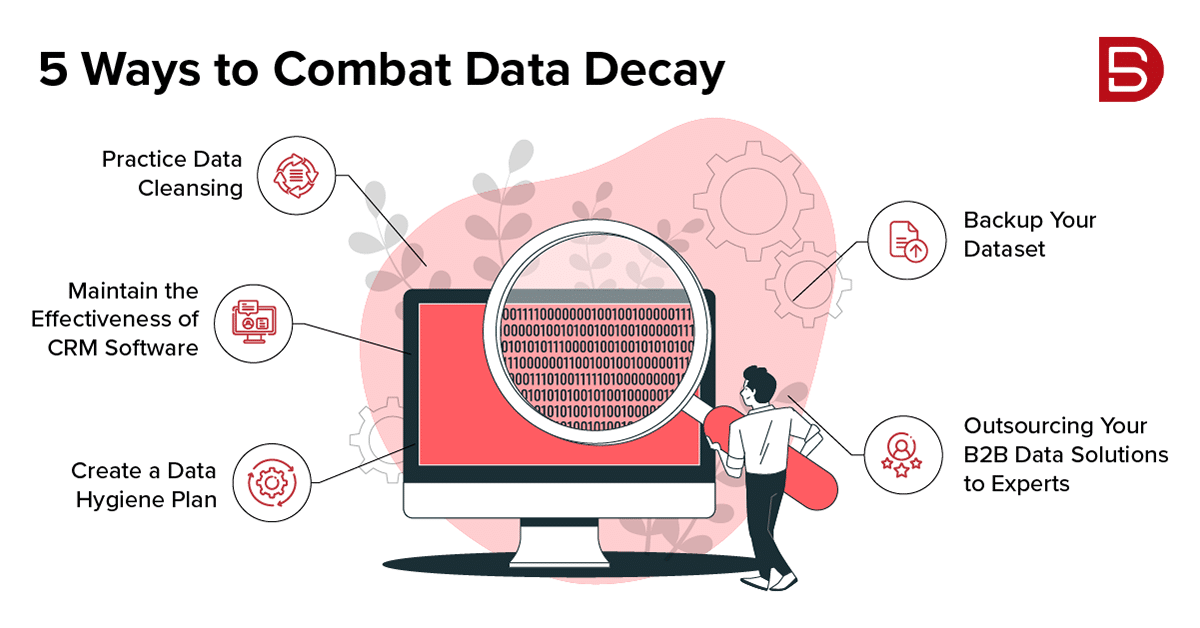According to the Global Data Management Report, 72% of business leaders consider data crucial for making important decisions because of the rapid move toward digital transformation. However, there’s a catch: 32% of those surveyed admit their data isn’t accurate, and 55% have trust issues with their data.
When it comes to B2B companies, the importance of regularly updating and maintaining data cannot be overstated. Sadly, this is a challenge many companies face, and it’s impacting their operational efficiency.
The consequences of mishandling data are significant. It leads to misallocation of resources, strained client relationships, and a loss of credibility. Moreover, relying on inaccurate data often results in missed opportunities, which can lead to unfavorable business outcomes. Astonishingly, this data mismanagement issue costs U.S. B2B companies a staggering $3.1 trillion in lost revenue annually.
So, the key takeaway is clear; to thrive in the digital era, businesses must prioritize data quality and actively combat constant data decay. This proactive approach is essential for making accurate decisions, staying competitive, and avoiding the many challenges of a data driven B2B landscape.
What is Data Decay?
Data decay is the gradual decline in the quality of your B2B database over time due to the inclusion of outdated, incomplete, or incorrect information. This deterioration makes it difficult for businesses, especially sales and marketing teams, to rely on their databases for accurate and up-to-date customer information.
The challenges of combating data decay include the need for ongoing attention and resources from your team. It’s a constant battle to prevent your data from becoming obsolete, requiring consistent efforts to maintain its accuracy. As businesses grow and customer information changes, keeping up with these changes can be resource-intensive and challenging to manage effectively.
A Guide to Data Quality Management
What Causes Data Decay?
Data decay can occur for various reasons, including software glitches, human errors, and the challenge of keeping up with the ever-expanding stream of information. On average, B2B data deteriorates at a monthly rate of 2.1%. However, several factors, such as your industry, target demographic, geographic location, and more, can influence your company’s data decay rate.
Unpredictable data decay rates result from a multitude of factors as well. For instance, Dun & Bradstreet says every half hour brings about changes such as 120 corporate addresses, 75 phone number updates, 20 CEO role changes, and the establishment of 30 new start-ups. Just imagine manually updating all these data points every half hour during your workday – it’s a daunting task.
Numerous pieces of information, like altered names, job titles, phone numbers, email addresses, and more, affect your database daily. The good news is that despite the seemingly overwhelming task of tracking these irregular changes and ensuring data quality, there are many effective strategies to combat data decay.
5 Ways to Combat Data Decay in B2B Sales & Marketing
It is an ongoing challenge that demands continuous attention. However, you can take steps to slow down the impact of data decay. Here are five valuable tips to maintain the accuracy of data in your B2B sales and marketing efforts:
1. Practice Data Cleansing
Data cleansing safeguards against data decay by systematically removing duplicates, errors, outdated records, and irrelevant data from your dataset. Doing so ensures that your data remains accurate, relevant, and reliable over time. This ongoing data cleansing process prevents the gradual deterioration of data quality that can occur as data accumulates and evolves. In essence, it maintains the data integrity and value of your data assets, making them a dependable foundation for decision-making, analysis, and reporting, even as time passes.
2. Maintain the Effectiveness of Your CRM Software.
Customer Relationship Management (CRM) technology is a valuable source of data for your dataset, saving time by tracking sales interactions and automating emails. To maintain data quality and prevent decay, follow these three guidelines when implementing CRM:
- Integrate Data Sources: Ensure both marketing and sales use the same CRM system to gather comprehensive information from various sources.
- Validate Data: Rigorously validate data as it enters the CRM system and additionally implement firewalls for accuracy.
- Use Data Segmentation: Categorize essential data, especially if dealing with multiple customer profiles, markets, or products, to improve data quality and manage it effectively.
3. Create a Data Hygiene Plan.
The most obvious strategy to prevent data decay is to keep your database current and updated with regular data hygiene checks as part of a routine. This procedure entails:
- Examining current data for updates
- Deleting duplicate contacts
- Verifying fresh contacts
- Filling the gaps in the information
Ensuring that everyone in your organization understands data hygiene standards is crucial. While departments like sales, marketing, or IT typically handle data hygiene checks, teamwork is the key to keeping your data in top shape!
4. Backup Your Dataset.
Hardware device malfunctions can potentially lead to data decay, which can have severe consequences. A staggering 94% of businesses that suffer significant data loss never manage to recover.
Just as you would take precautions with important files on your phone and laptop, it’s essential to securely store your data in the cloud. This minimizes the risk of losing valuable information and ensures disaster recovery. Cloud storage is the most reliable and secure method for data backup, offering various options to suit your specific needs and preferences.
However, it’s crucial not to overlook data security. Safeguard your data access and fortify it against external threats to ensure its protection.
5. Consider Outsourcing Your B2B Data Solutions to Experts.
The future of B2B sales leans heavily on data-driven solutions. Having accurate data at your team’s disposal can boost customer satisfaction, optimize resource allocation, and guide smarter strategic decisions. Yet, let’s be honest, managing data isn’t a walk in the park.
If you choose to go the first-party data route, be prepared to tackle some challenges in building a robust dataset. Alternatively, if you’re short on time or resources, you can opt to bring in B2B data solutions experts to handle this task for you. These professionals can efficiently provide tailored data solutions that align with your company’s Ideal Customer Profile (ICP). It’s a practical shortcut to data excellence.
Maintaining Data Quality in B2B Sales
In the world of B2B sales, accurate databases are a real asset. They help your sales teams understand your customers better, enabling them to create targeted lead lists and engage with prospects effectively. However, here’s the thing: using the right data is key- data that’s relevant and current. Neglecting to address data decay can lead to significant issues. If you wish to avoid the hassles of data decay, write to us at marketing@datamaticsbpm.com. Our b2b data solutions and data enrichment services can help you keep your data fresh and your B2B sales on the right track.
 Select an element to maximize. Press ESC to cancel.
Select an element to maximize. Press ESC to cancel.
James Libera



